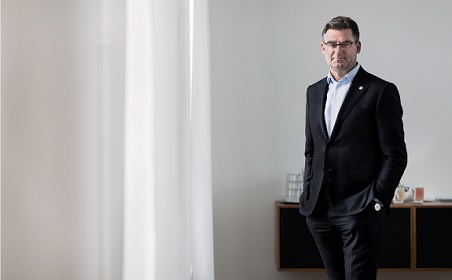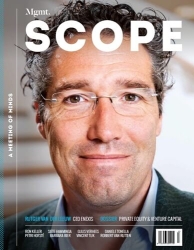'Existing positions give way to new roles'

13-04-2018 | Interviewer: Stef Oud | Auteur: Paul Groothengel | Beeld: Clément Morin
Management Scope is visiting Samsom, originally a gastroenterologist and former top executive at Radboudumc, in Stockholm, the Swedish capital. He feels at home and speaks Swedish reasonably well. It is not Samson’s first foreign job: previously he worked as a researcher at the Mayo Clinic in the United States and at the Royal Adelaide Hospital in Australia. When he started this job almost four years ago, the Karolinska University hospital, the largest in Sweden, was in the red: on a turnover of EUR 1.6 billion it suffered a loss of EUR 60 million. Two years ago he already said in an interview in the medical journal Medisch Contact that a radical change was necessary: ‘We wouldn’t pull it off by scrapping things or making a few cuts here and there. We had to take a fundamental approach.’
That resulted in his plan to adopt another organizational structure. Traditional departments, such as cardiology, surgery and internal medicine, have disappeared and given way to ‘patient paths’, which were developed in consultation with patients, doctors and nurses. These patient paths are thematically arranged, for example ‘cancer’, ‘woman and child’ and ‘heart and vessels’. A patient with breast cancer then faces specialists grouped around breast cancer care: oncology, surgery, radiology and plastic surgery. Multidisciplinary groups have designed the care process and prepared the KPIs. A new manager, known as the Patient Flow Captain, is responsible for them. The PFC has been created to manage the multi-disciplinary team and is a professional who is actively engaged in the daily care of patients. In this way, the patient receives a properly coordinated treatment and the PFC monitors the process and the therapy real-time.
It is rather unique that a hospital puts the patient at the heart of its organization to this extent, Samsom agrees. His approach seems to be successful, but it also caused some unrest in the workplace. For example, medical specialists found it difficult to suddenly have to work with other specialists, grouped around a specific patient group. Karolinska is not the only hospital where highly specialised, tailored patient care is provided, arranged around the patient. It is new that this is done in a hospital-wide manner and that the departmental structure is abandoned. In the Netherlands, too, there are hospitals that work thematically, but they do so while maintaining the traditional departmental structure.
What are the main differences in healthcare between Sweden and the Netherlands?
‘A striking difference is that in the Netherlands, patient participation has developed much further than in Sweden. In addition, we have a healthcare system here that is very different from that in the Netherlands. In the Netherlands, I sat down at the table with at least six health insurers, but in Sweden the saying ‘one payer, one owner’ applies. The owner of our hospital is the county, or the provincial government, which owns the other hospitals in our region as well. Healthcare is financed from taxes. As a care administrator in the Netherlands, you have to deal with strict competition rules, but here you can easily and quickly cooperate with other hospitals.’
So there is no competition?
‘Hardly any. Every two weeks I consult with the administrators of the other hospitals how best to divide care duties between the various hospitals. The paying party, the provincial government, takes a seat at the table as well. That works very well. Intensive consultation is not necessary, if only because Stockholm’s population increases yearly by 40,000. We are already faced with a capacity problem.
At Karolinska, we are still working with outdated infrastructure now. The last new hospital in the county was built 40 years ago, that is our hospital at the Huddinge campus. Our new building at the Solna campus is the largest and most modern university hospital in Europe. We are now in the process of transferring 300,000 of our 1.7 million annual patient visits to other hospitals. It concerns patients who do not need the care of a university hospital directly, including a number of chronically ill people.’
Previously, you managed the Radboudumc in Nijmegen. Can you manage the hospital here according to the same management style as in the Netherlands?
‘No. Swedes are far more focused than the individualistic Dutch on achieving consensus, on collective interests. That also means discussing everything together, I really have to take that into account. When I took up my duties here, meetings were held every Monday from 12 am until 5 pm, with 22 persons! That was really not possible. I wanted to halve that meeting time and that was more than successful.’
What was the reason for so radically changing the existing organizational model of Karolinska?
‘The basic assumption was that the organizational form should be derived from the way you want to work. We were looking for a model that suits the major external changes that concern us. For example, patients − I prefer to call them people with a disease − are becoming increasingly emancipated. They don’t want to wait too long and enter into a dialogue with their treating physician. In addition, we are dealing with increasing possibilities through digitization and improved technology. Internally, we had reasons to change as well. Because of silo formation, people in one department were often not well informed about what the other department had done with the patient, or were planning to do. In addition, we had to be able to better manage the ever increasing costs. Our choice for the new organizational model was not made overnight: we conducted intensive internal consultation for nine months. I confronted our people with the model presented by the author Simon Sinek: what is our why? Do we know why we do what we do? What helped us in a practical sense was that in the renovation of one of our buildings the possibility of thematic working was clearly taken into account.’
What are the main obstacles in the transfer from departments to patient paths?
‘Doctors, much more than nurses, consider it difficult to exchange their familiar structure for something unknown. We know that from cancer centres that stopped with their department structure and switched to another model: it takes a lot of time to ensure that an organizational structure has been implemented and that is actually accepted by both physicians and nurses and other medical professionals. This is partly because existing position cease to exist and new roles are defined. We are now in a transformation phase and are continually holding dialogues with our people. Another obstacle is patient waiting lists: patients often have to wait a long time for their operation. In addition, we are dealing with a shortage of beds, which also constitutes a major problem throughout Sweden.’
Swedish consumers and companies are pretty tech savvy, we know from experience. Is that reflected in Swedish hospitals, are they, for example, very active in digital applications?
‘Indeed, digitization started here at an early stage. But when I started here, I realised to my surprise that patient files had not yet been opened to patients. I introduced that in the Radboudumc years ago: for example, we published the success rates of cancer treatments and heart operations there. At the time, we were the first hospital to do this in the Netherlands, later others followed. Now we have arranged for this at Karolinska as well. One major plus here is that we have connected our Take-Care − what the electronic patient file, or EPD, is in the Netherlands − to all care institutions and general practitioners throughout the region, with the exception of private institutions. This works very efficiently and transparently.’
Can you, with the aid of artificial intelligence, already derive any interesting patterns from the data of your patients, enabling you to improve healthcare?
The Karolinska is at a turning point for that matter. Here in the region we have an incredibly rich patient database. We know exactly who our patients are, what care institutions they attend, what treatments they have undergone there, what the costs were, what medication they use, et cetera. With all healthcare institutions in the region we are sitting on a huge mountain with interesting data. The question is now what information and patterns we want and are able to distil from that. That’s the next step. We experiment with artificial intelligence, want to really develop that knowledge and expertise within our own hospital.’
How do you organize the latter? Have you, for example, appointed a Chief Digital Officer?
‘No, but an experienced Chief Information Officer, who comes from a different sector: who now hires a variety of IT specialists.’
Smart algorithms are playing an increasingly important role in medical equipment as well. How do you use these opportunities?
‘In the development of our new building we have acquired a lot of new, heavy technology, worth some 300 million euros. With a number of suppliers, including Philips and GE, we have entered into long-term partnerships, for example in the area of radiology, pathology and genetic research. You see that suppliers no longer just want to sell products, but increasingly the services around them. That is promising and often inspiring as well, but at the same time, we have not struck the optimal balance in such partnerships yet.’
What is the debate like in Sweden about the importance of cybersecurity and privacy, specifically where it concerns an EPD or a remote diagnosis?
‘In Sweden citizens have had a well-secured personal identification number for years. That gives you access to your bank, your supermarket, your medical data, you name it. That’s great, but meanwhile, we increasingly deal with digital intrusions in our systems. Because of the upcoming new European legislation about privacy, our patients and partners increasingly receive questions about this subject. The most important thing is that digitalisation will offer more and more possibilities. In this way we strive to enable people to treat themselves, think of people with diabetes, and in addition, to treat people more and more at home. People prefer that and it is also cheaper. We are improving that: for example, our neonatology department has now launched an initiative to take care of prematurely born babies at home, of course with digital support and monitoring.’
What are the first results after the transformation to an institution based on patient paths?
‘People are working incredibly hard, the results are generally good. Even though we have appointed 650 new managers and 30 percent of our people have moved to a new building, where not everything was working properly immediately. The healthcare we provided in 2017 was 99 per cent of what we had contracted. The medical quality? In 2014, we were at the bottom of the list with six other hospitals. Last year we climbed to second place, so we have clearly made progress on this crucial issue. In addition, our research results are better than ever. We recently conducted a survey among our patients, asking if they would recommend the Karolinska to friends and family, and 91 percent said yes. Those are encouraging figures. We see that employees had to leave their comfort zone and really feel or have felt the pressure to change. But at the same time, we provide healthcare and conduct scientific research at a very high level. I am very happy about that.’
INTERVIEW: Stef Oud, partner at A.T. Keamey and digital transformation leader. Oud interviews and writes for Management Scope about new business models and organisations in transition. These contributions can be found under his profile.


